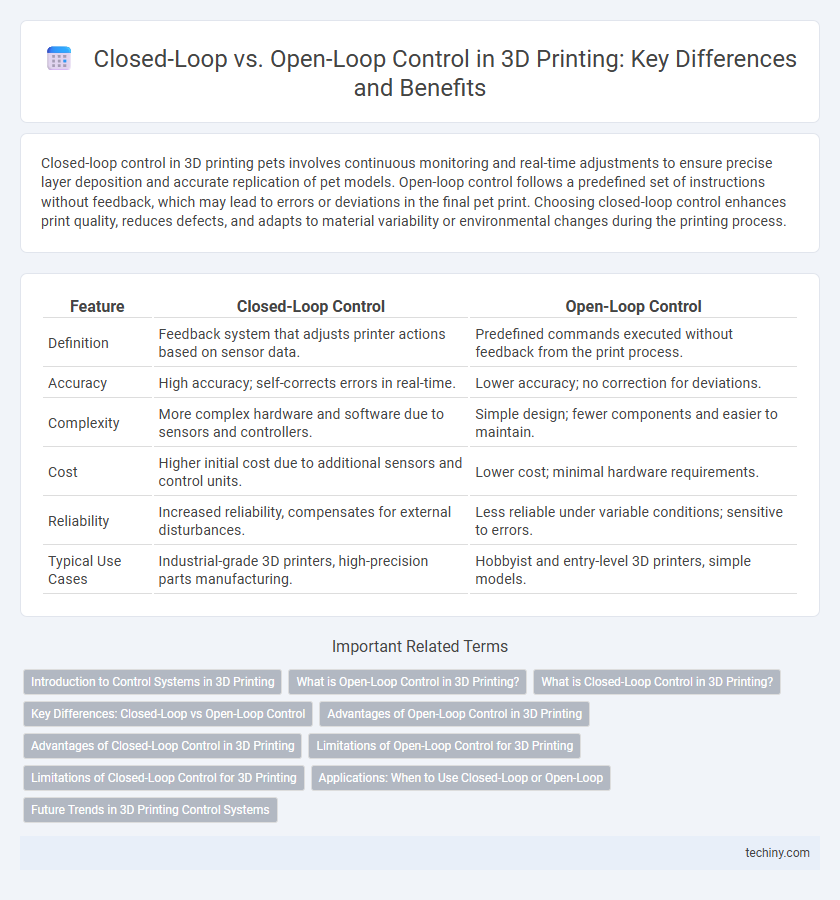Closed-loop control in 3D printing pets involves continuous monitoring and real-time adjustments to ensure precise layer deposition and accurate replication of pet models. Open-loop control follows a predefined set of instructions without feedback, which may lead to errors or deviations in the final pet print. Choosing closed-loop control enhances print quality, reduces defects, and adapts to material variability or environmental changes during the printing process.
Table of Comparison
| Feature | Closed-Loop Control | Open-Loop Control |
|---|---|---|
| Definition | Feedback system that adjusts printer actions based on sensor data. | Predefined commands executed without feedback from the print process. |
| Accuracy | High accuracy; self-corrects errors in real-time. | Lower accuracy; no correction for deviations. |
| Complexity | More complex hardware and software due to sensors and controllers. | Simple design; fewer components and easier to maintain. |
| Cost | Higher initial cost due to additional sensors and control units. | Lower cost; minimal hardware requirements. |
| Reliability | Increased reliability, compensates for external disturbances. | Less reliable under variable conditions; sensitive to errors. |
| Typical Use Cases | Industrial-grade 3D printers, high-precision parts manufacturing. | Hobbyist and entry-level 3D printers, simple models. |
Introduction to Control Systems in 3D Printing
Closed-loop control systems in 3D printing continuously monitor the printing process by using sensors to detect deviations and adjust parameters in real-time, ensuring higher accuracy and consistency. Open-loop systems operate without feedback, relying solely on pre-set commands, which can lead to errors if unexpected variables affect the print. Incorporating closed-loop control enhances print quality by dynamically compensating for variations in temperature, material flow, and mechanical movements.
What is Open-Loop Control in 3D Printing?
Open-loop control in 3D printing refers to a system where the printer operates based on pre-set instructions without feedback from sensors to adjust the process in real time. This method relies on accurate calibration and assumes consistent conditions throughout the printing process, making it simpler but less adaptable to variations such as material inconsistencies or environmental changes. Open-loop control systems are common in basic 3D printers where precision feedback mechanisms like temperature or layer alignment sensors are not implemented.
What is Closed-Loop Control in 3D Printing?
Closed-loop control in 3D printing uses real-time feedback from sensors to continuously monitor and adjust printing parameters such as temperature, extrusion rate, and layer alignment, ensuring high precision and consistent quality. This system detects deviations during the printing process and automatically corrects errors, reducing defects and material waste. Advanced closed-loop control enhances print accuracy, reliability, and repeatability compared to open-loop control systems.
Key Differences: Closed-Loop vs Open-Loop Control
Closed-loop control systems in 3D printing continuously monitor the printing process using real-time feedback from sensors to adjust parameters like temperature and extrusion rate, ensuring higher accuracy and consistency. Open-loop control systems operate without feedback, relying solely on pre-set instructions, which can lead to errors and reduced precision in complex prints. Key differences lie in error correction capabilities and adaptability, with closed-loop systems offering improved reliability by dynamically responding to process variations during printing.
Advantages of Open-Loop Control in 3D Printing
Open-loop control in 3D printing offers simplicity and cost-effectiveness by eliminating the need for feedback sensors, reducing system complexity and maintenance requirements. This control strategy enables faster processing speeds and easier integration with a wide range of printers, making it ideal for straightforward, repetitive printing tasks. By minimizing hardware dependencies, open-loop systems provide enhanced reliability in controlled environments where precision adjustments are less critical.
Advantages of Closed-Loop Control in 3D Printing
Closed-loop control in 3D printing offers enhanced precision by continuously monitoring and adjusting the print process based on real-time sensor feedback, reducing errors and material waste. This system improves print quality and consistency, particularly in complex geometries or variable environmental conditions. Manufacturers benefit from increased reliability and reduced downtime due to the ability to detect and correct deviations during the printing process.
Limitations of Open-Loop Control for 3D Printing
Open-loop control in 3D printing lacks real-time feedback, leading to inaccuracies in layer deposition and dimensional errors, especially with complex geometries. Variations in filament properties, temperature fluctuations, and mechanical wear further exacerbate print quality issues without corrective adjustments. This absence of dynamic error correction restricts the consistency and reliability required in high-precision additive manufacturing applications.
Limitations of Closed-Loop Control for 3D Printing
Closed-loop control in 3D printing faces limitations such as increased system complexity and higher costs due to the need for real-time sensor feedback and processing. Sensor inaccuracies and delays can result in suboptimal corrections, affecting print quality and consistency. Additionally, the closed-loop systems may struggle with rapidly changing conditions or unexpected disturbances during the printing process, limiting adaptability.
Applications: When to Use Closed-Loop or Open-Loop
Closed-loop control in 3D printing is ideal for high-precision applications such as aerospace and medical devices, where real-time feedback ensures dimensional accuracy and reduces defects. Open-loop control suits simpler, cost-sensitive projects like prototyping and hobbyist models where process variability is tolerable and feedback mechanisms are unnecessary. Selecting between closed-loop and open-loop depends on the balance between accuracy requirements, budget constraints, and complexity of the printed object.
Future Trends in 3D Printing Control Systems
Future trends in 3D printing control systems emphasize the integration of advanced closed-loop control mechanisms to enhance print accuracy and material utilization. Artificial intelligence and real-time sensor feedback enable adaptive modifications during printing, reducing defects and ensuring higher consistency. The shift from open-loop to closed-loop systems is driven by demands for precision, scalability, and automation in customized manufacturing processes.
Closed-Loop vs Open-Loop Control Infographic

 techiny.com
techiny.com